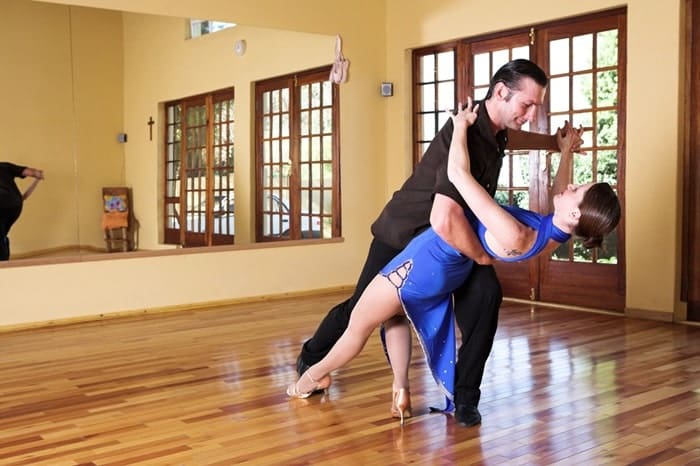Tips to Reduce Ballroom Dancing Injuries
Dancers can reduce their risk of injury by following a few simple expert-recommended tips, starting with those listed below.
1. Invest in High-Quality Dance Shoes
Dancers depend on high-quality shoes to ease across the dance floor and reduce their risk of injury. The importance of choosing the right shoes for your dance style cannot be overstated. The decision to invest in high-quality ballroom dance shoes is the best step in caring for your feet and legs.
When selecting dance shoes, choose a pair that fits snugly against the heel but offers wiggle room for your toes. Choose an appropriate heel height for your dance style. The heel of a shoe greatly affects its comfort, stability, and movement capabilities.
Short heel shoes come in heights ranging from 1.5 to 2.5 inches, giving them more stability and support than shoes with higher heels. The natural positioning of the foot ensures weight is distributed evenly across the body, reducing the pressures on the balls of the feet and the toes. This helps reduce the risk of ankle sprains and other foot-related injuries.
Additionally, choosing short heels can help reduce strain on the lower back, preventing pain in the back and on the calves of the legs.
Short heels work well for new and well-experienced dancers alike, particularly during practice dance sessions.
2. Warm-Up Before Dancing
Never jump into a dance routine before a warm-up. A quick warm-up, whether preparing for practice or competition, eases your body into physical activity, which can increase flexibility, improve blood flow and circulation, and properly prepare the muscles for extreme movement.
When dancers warm up first, they reduce the risk of serious strains, sprains, and other injuries and enjoy the potential of executing even the most difficult moves with ease.
Beneficial ways to warm up before dancing include:
- Light cardio exercises like walking, jogging, and basic dance steps increase your heart rate and warm up the muscles, so they are ready to move in even the most unusual positions.
- Engage in dynamic stretching exercises, including shoulder circles, arm circles, and torso twists, which loosen muscles and joints for more fluid movement while dancing.
3. Strength-Building Exercises
Strength-building exercises make your body stronger, so you are physically capable of performing flawless moves. The exercises enhance muscle mass and offer benefits like:
- Increases flexibility
- Decreases your risk of falls
- Improves heart heart
- Reduce the risk of injury
- Promotes mobility
- Boosts your mood for greater confidence during practices and competitions alike
- Help avoid unnecessary strain and pressure on the muscles and joints
Core exercises help strengthen your back muscles, improve balance, and restore physical performance. The exercises are important for dancers who need the capability to move with strength and precision. Leg raises, planks and mountain climbers are great beginner-core exercises to get you started.
Finally, work on those legs! As a dancer, it is essential that you have strong, flexible legs. Focus on exercises that work the legs, like squats and lunges, to keep the body stable and capable of performing the most intricate footwork.
4. Maintain Proper Posture
Proper posture plays a huge role in injury prevention. When you maintain correct alignment, you reduce unnecessary stress on your muscles and joints. To maintain proper posture, stand with your back straight, shoulders relaxed, and head held high. Always engage core muscles to support your spine and maintain balance. This helps prevent lower back strain and ensures you can easily perform moves requiring even the most intricate footwork during your performance.
5. Take Time to Rest When Necessary
We often ignore cues from our body telling us we need rest, especially when dancing and participating in activities we love the most. Dancers who do not take time to rest and who refuse to listen to their bodies are doing themselves a disadvantage since extended periods of dance can lead to increased fatigue-related injuries.
Listen to your body and take time to rest when necessary. Listening to your body can significantly reduce the risk of joint and muscle pain and strain.
- Your body needs time to rest and recover. Take time between practice sessions and competitions. Listen to your body when and if it tells you it’s time for rest.
- Proper hydration fuels your body as you dance. Muscle cramps, dizziness, and other problems may occur if you become dehydrated. Water and drinks like Gatorade are your best friend.
The Facts on Ballroom Dancing Injuries
About 64% of ballroom dancers experience an injury during their careers. The level of competition and intensity of training affect injuries. The most common injuries dancers experience include sprains and strains, and back pain. One recent study found that ankle injuries account for approximately 20% of all ballroom dance injuries. The risk is higher among competitive dancers.
Prevention strategies are important in reducing injury rates and maintaining your elegance on the dance floor. Studies show that dancers who participate in warm-ups, practice core, and strength training exercises, listen to their bodies, and regularly follow the safety information outlined above reduce their risk of injury by approximately 30%.
Final Thoughts
Let’s be honest: ballroom dancing is difficult. Otherwise, we’d all strut our stuff on the dance floor and become the next Fred Astaire. It is physically demanding and challenging yet beautifully rewarding and amazingly fun. Without proper care, however, dancers may find their time on the dance floor limited. Keep yourself healthy and injury-free by using the tips outlined here. Your body will thank you later.


